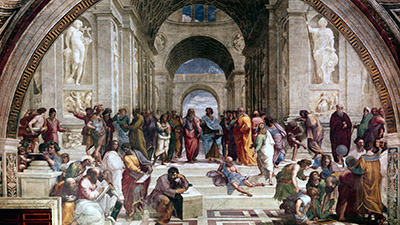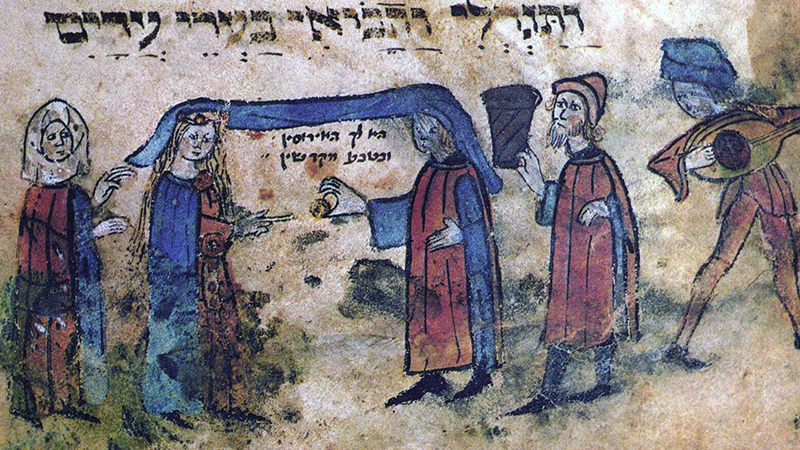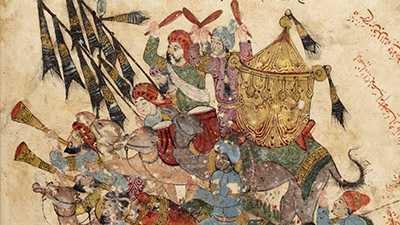Cultural Consequences
Teacher Resources
Driving Question: What were the positive and negative consequences of increased connectivity?
Networks of exchange across Afro-Eurasia moved science, technology, and culture to new places. Religions spread, as did advancements in fields such as astronomy, medicine, and mathematics. The circulation of all these innovations contributed to the development of a global body of knowledge.
Learning Objectives:
- Learn about how trade produced technological and scientific innovations.
- Assess the religious conflicts and transformations that took place in this period.
- Develop the historical thinking skill of causation and understand how causes and consequences vary depending on how an event is framed.
Vocab Terms:
- causation
- consequence
- culture
- maritime
- migration
- society
- trade
Opener: Cultural Consequences
To teach this lesson step, refer to page 2 of the Lesson 2.8 Teaching Guide.
Reflect on what you’ve learned about the causes and consequences of increased connectivity in this period.
Causation and the Camel
To teach this lesson step, refer to page 3 of the Lesson 2.8 Teaching Guide.
We love Alphonse, but he’s just the tip of the iceberg. For all things causation, check out this topic page.
Alphonse the Camel had a difficult life, but what caused his demise? Let’s explore this poor camel’s end and get to the bottom of this mystery!
Renaissance Narratives
To teach this lesson step, refer to page 4 of the Lesson 2.8 Teaching Guide.
Want to know what other teachers think about teaching the Renaissance? Take a look at this conversation in our online teacher community.
In the fourteenth century, a cultural renaissance was rocking Europe as a result of centuries of cross-continental exchange.
-
Guiding Questions
-
Before you read
Preview the questions below, and then skim the article. Be sure to look at the section headings and any images.
While you read
Look for answers to these questions:
- What was the Renaissance?
- What did Renaissance thinkers and artists in Italy believe they were doing?
- How did different types of people experience the Renaissance?
- How did trade help start the Renaissance?
- What does the painting “The King’s Fountain” shows us about life in Renaissance Europe?
After you read
Respond to this question: How would you describe the Renaissance to somebody who knew nothing about it?
Changing Belief Systems
To teach this lesson step, refer to page 5 of the Lesson 2.8 Teaching Guide.
Belief systems can be a tricky topic. Be sure to check out Teaching Sensitive Topics in Social Studies.
What we believe or think can be affected by anything from new ideas to new technology. What might influence or change what you believe over time?
-
Guiding Questions
-
Before you read
Preview the questions below, and then skim the article. Be sure to look at the section headings and any images.
While you read
Look for answers to these questions:
- What is the Jewish diaspora, and how did it influence Judaism in the period from 1200 to 1450?
- What effect did the development of Hinduism have on societies in South Asia?
- To what does the author attribute the spread of Buddhism? Where did it spread?
- How did interaction with the Roman Empire change the development of early Christianity?
- What are the five pillars of Islam?
After you read
Respond to this question: The communities frame narrative for this course asserts that human communities generally grow larger and more complex over time. Belief systems are one form of human community, and this article covers several millennia. How does this article help you support, extend, or challenge this narrative?
-
Guiding Questions
-
Before you watch
Preview the questions below, and then review the transcript.
While you watch
Look for answers to these questions:
- What sixteenth-century practices of the Catholic Church and its pope led people to accuse the church of corruption?
- What criticisms of the Catholic Church did Martin Luther make in his Ninety-five Theses?
- Why was Protestantism appealing to women and what contributions did some women make to the movement?
- How did the Reformation lead to the death of millions of people?
- Who were the Jesuits and why was this order created?
After you watch
Respond to this question: In what ways is the sixteenth-century Protestant Reformation still relevant today?
Key Ideas
The Past Is a Foreign Country
Group Problem-Solving: Together or Alone?
Try this: Present students with a historical dilemma. In the fourteenth century, the Guanche people were living in the Canary Islands off the northwest coast of Africa. In 1312, an Italian navigator named Lancelotto Malocello landed on the island.
- Have student role-play as islanders deciding whether to remain isolated or engage with outsiders.
- They develop 10 questions to ask Malocello, then prompt AI for more.
- After refining the list, students compare how AI shaped their thinking.
Behind the design: Students learn that AI can help expand how we ask questions. They deepen their understanding of historical dilemmas and the risks and rewards of global connectivity.
Was the thirteenth century that different from life today? In some ways, yes—in others, no. Let’s find out just how similar or different they are.
Closer: Cultural Consequences
To teach this lesson step, refer to page 12 of the Lesson 2.8 Teaching Guide.
You’re probably starting to see that there’s a positive and negative side to many historical events. Weigh the pros and cons of cross-cultural exchange and transformation.
Culture and Consequence
To teach this lesson step, refer to page 12 of the Lesson 2.8 Teaching Guide.
Trade, war, and pilgrimages often lead to cultural diffusion, and societies are forever changed by them. Find out how.
-
Guiding Questions
-
Before you read
Preview the questions below, and then skim the article. Be sure to look at the section headings and any images.
While you read
Look for answers to these questions:
- Did most people in Afro-Eurasia travel extensively between 1200 and 1450?
- In this same period, what two main regions/cultures of Afro-Eurasia made the most remarkable contributions to technology throughout other regions?
- What were some of the major technological contributions made by China and the Islamic world in this period (1200 to 1450)?
- What different religious traditions came together in Southeast Asia in this period?
- What shape did Islam take in many of its movements and adaptations around the region?
After you read
Respond to this question: Why do you think people were willing—or even enthusiastic—to adopt ideas coming in from other places? What were their motives?







